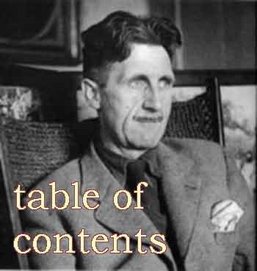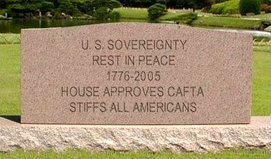
Black World Not Ours
The State of the Black World Conference, held in Atlanta at the end of October, celebrated the view that blacks are not really part of America. Rev. Al Sharpton was met with a thunderous standing ovation from 700 delegates when he taunted the American military for failing to find Osama bin Laden. “This country can’t find a guy who comes out every two weeks to cut a video, and then you challenge us to stand under one flag?” He urged the crowd to take on the problems of blacks rather than those of the nation.
Cosme Torres, deputy ambassador of Cuba to the United Nations, also got a warm welcome. He said people from 24 different countries attend Cuba’s medical school whereas the United States has “millions of people without health care.” “Cuba is right there, ready to build solidarity for the revolution,” he added. “The Negroes of Cuba day after day make the dream of their ancestors a reality.” [Steve Miller, Black World Conference Loses Its Audience, Washington Times, Dec. 1, 2001, p. A3.]
WOW THIS GUY WAS A CANDIDATE IN THE 2004 DEMOCRAT PRESIDENTIAL PRIMARY! SCARRY, DON'T YOU THINK?
THE FOLLOWING PASTED INFORMATION IS FROM GOOGLE (NO INFORMATION TO CITE).
Economy of Cuba - The economy of Cuba is based on state ownership with some small scale private enterprise existing. Hiring labour, however, is not allowed, on the theory that private employment may lead to worker exploitation. Major problems are the narrow basis of the economy (traditionally little more than sugar), the U.S. embargo, hurricanes and the fall of the Soviet Union.
Traditionally, sugar, tobacco and (later) nickel were the main sources of income for Cuba. But in the 1990's tourism saw an explosive growth. In 1993 the U.S. dollar was made legal tender (the country operated under a dual-currency system); this arrangement was, however, revoked on 25 October 2004. At that time, use of the dollar in business was officially banned, and a 10% surcharge was introduced for the conversion of dollars to convertible pesos, the island's new official currency. Other currencies, including the Euro, were not affected. See details at Ludwig Van Mises Institute.
The Cuban economy was hit hard in the early 1990s following the collapse of the Soviet Union and the Comecon economic bloc, with which it had traded predominantly. For several decades, Cuba received what was effectively a Soviet subsidy, whereby Cuba provided the Soviet Union with sugar and the Soviets provided Cuba with petroleum at unrealistic prices. In response, Cuba opened up to tourism, which is now a major source of income.
More recent problems include high oil prices, recessions in key export markets such as sugar and nickel, depressed tourism, and faltering world economic conditions. In late 2003, and early 2004, both tourism levels and nickel prices increased. One other factor in the recovery of the Cuban economy is the remittances of Cuban-Americans (which constitute almost 3% of the Cuban Economy, by some estimates). However, Cuba owes billions in Paris Club debt to nations such as France, Japan and Germany.
Cuba currently trades with almost every nation in the world, albeit at a very small scale because under the U.S. embargo any company that deals with Cuba is barred from dealing with the United States, so internationally operating companies are forced to choose between Cuba and the United States, which is a much bigger market. This extraterritorial U.S. legislation is considered highly controversial, and the U.S. embargo was condemned for the 13th time in 2004 by the General Assembly of the United Nations, by 179 countries (out of 183). The main current trading partners of Cuba are: Spain, Venezuela and Canada. In time as China normalises relations with the Caribbean, China may also become a more important Cuban trading partner.
The United States bans its citizens from travelling to Cuba. Nevertheless, U.S. citizens can visit Cuba by travelling through other countries (like Mexico, Canada or the Bahamas) because Cuban immigration does not stamp the passports (the visum is a separate leaflet). However, U.S. citizens are liable to fines if discovered and prosecuted by the U.S. Government, although it has been reported that U.S. authorities are not overly strict with this.
Although struggling with its economy since the fall of the Soviet Union, Cuba has seen substantial improvements since the early 1990s.
A major problem is damage from hurricanes. In 2004, Hurricane Charley, (August 12) caused an estimated 1 billion dollars economic damage, followed by Hurricane Ivan (September 13). In 2005, Hurricane Dennis (July 8) struck south-central Cuba. This is a problem that all Caribbean islands suffer from and an argument Castro uses to urge the islands to cooperate, promoting an agreement that is a sort of international insurance, so that if one island gets hit the other islands will help it out. He says that if the United States get hit, the economy of other parts of the country will take the blow, but if a Caribbean island gets hit, that may devastate the entire economy.
Cuba is notable for its national organic agriculture initiative. In the early 1990s, post-Soviet Union, Cuba lost over 70% of agricultural chemical imports, over 50% of food imports, and an equally significant amount of oil. Its agricultural sector, built on a large-scale, mechanized, chemical-based model, was instantly crippled. By restructuring its agricultural industry, and focusing scientific efforts on organic solutions, Cuba managed to rapidly and successfully convert the country to entirely organic production. Currently, only organic agriculture is permitted by law. Today, Cuba is a leading nation in Biotechnology
According to UNESCO research, Cuba's primary school students have almost twice as much knowledge as the average student in the rest of Latin America. In a 1998 study by UNESCO, Cuban third and fourth graders were better educated in basic language and mathematics skills than children in all other Latin American countries that took part in a study.
On a total population of 11 million, Cuba has 250,000 educators, 67,500 medical doctors, and 34,000 physical education and sports professors and technicians.[2]
For 2005, 68% of the state budget spending is to be directed to raising the levels of education, public health, social security, culture, sports and science and technology.








No comments:
Post a Comment